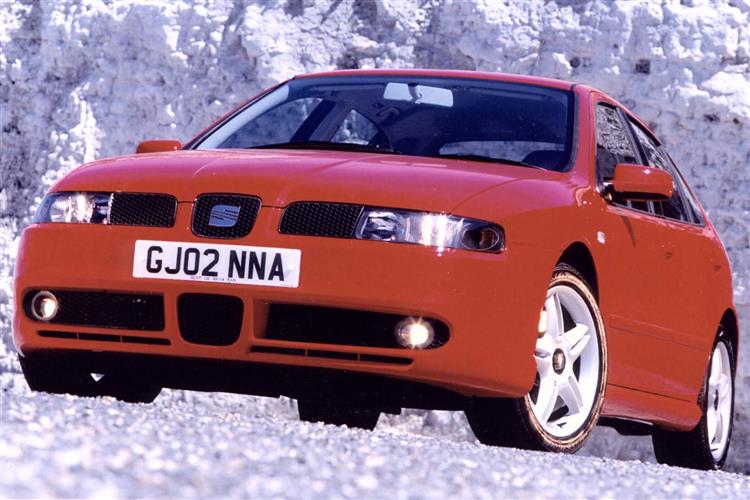THE LEON KING (some text hidden) --NONE--
BY ANDY ENRIGHT
Introductionword count: 91
Success can be a double edged sword. SEAT weren't expecting their Cupra versions of the Leon to sell quite as well as they did and while they were overjoyed at the contribution the Cupras made to their bottom line, it soon became apparent that few people were buying any other sort of Leon. With over 60 per cent of UK Leon sales accounted for by the sports models, there's no shortage of choice for used buyers looking to get a deal on a car that was very good value from new.
Modelsword count: 12
Models Covered: (5 dr hatch, 1.8 petrol, 1.9 diesel [Cupra, Cupra R])
Historyword count: 266
The Leon was launched in March 2000 and the first Cupra was something rather special. Powered by a breathed-upon version of the trusty Volkswagen Group turbo 1.8, it was good for 180bhp and came very generously equipped, albeit with a £17,815 price tag. Based on a platform which also spawned the Volkswagen Golf and Bora, as well as Audi's A3 and Skoda's Octavia, the Leon used tried and tested underpinnings. Saddled with this price tag, the Leon 20VT Cupra, as it was known, was rather a slow seller, so in October 2001 SEAT took a rather radical step. The Cupra model was 'decontented', and was now based on the Sport specification. Buyers did without refinements such as a leather interior, rain sensing wipers, auto-dimming rear view mirror and ESP stability control program. Although leather could be specified as an option on the new version, ESP couldn't, making the earliest 20VT Cupras quite a find. The best bit was that SEAT dropped the price to £14,995. Suddenly Leon Cupras were flying out of showrooms and buyers of the early cars watched their residuals crumble. In mid 2002, Leon buyers got an even spicier option with the introduction of the 210bhp Cupra R version, later updated to 225bhp specification in Autumn 2003. A 150bhp TDI Cupra was introduced in late 2003 , the diesel model accounting for a big slice of Cupra sales before the range was phased out in 2005, replaced by an all new Leon in September of that year. With a gap in production before the second generation Leon Cupras arrived, SEAT missed a trick.
What You Getword count: 324
Let's start with the much-vaunted 'Mediterranean Spirit' - at which point even the most ardent SEAT enthusiast has to admit that this is no Alfa Romeo. That, however, doesn't mean the Leon isn't a refreshing change from the family hatchback norm. For a start, it appears to be longer than Astra or Focus-class alternatives (from the outside at least) and is (not that this means a bigger cabin). The styling's smart and purposeful too, although it looks a little dated compared with its futuristic successor. The Leon Cupra was offered in a four-wheel drive form in Europe but we only ever got the front-wheel drive model. Never mind, you still get the same 180bhp turbocharged 1.8-litre engine - the same as you'll find in the Audi TT sportscar. How many other family hatchbacks can offer up such a tempting mechanical recipe? As you might guess, the Cupra was there to generate showroom traffic although that target never really materialised. Those familiar with the marque will instantly recognise it as a five-door version of its close cousin, the Toledo saloon (which is 220mm longer) - though to be fair, there's a bit more to it than that. The rear section is cleverly crafted, with nice touches like a boot handle incorporated into the SEAT logo. Space in the back isn't huge by Toledo standards but is more than adequate for the smaller family hatchback sector in which this car competes. Even so, you can understand why SEAT decided not to do a three-door version. Sheer space apart however, that interior should be seen as one of the SEAT's strongest suits. Like all VW-sourced products, you feel behind the wheel that you're in something much more expensive, thanks to the choice of trim materials and the way the switches and stalks snap into place with an expensive click. There are lovely touches everywhere, including red backlit instruments and a steering wheel adjustable for rake and reach.
To see the full road test text contact us on 0330 0020 227
Pictures (high res disabled)

Scoring (subset of scores)
Category:
| Performance | |
| Handling | |
| Comfort | |
| Space | |
| Styling, Build, Value, Equipment, Depreciation, Handling, Insurance and Total scores are available with our full data feed. | |



